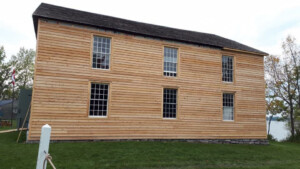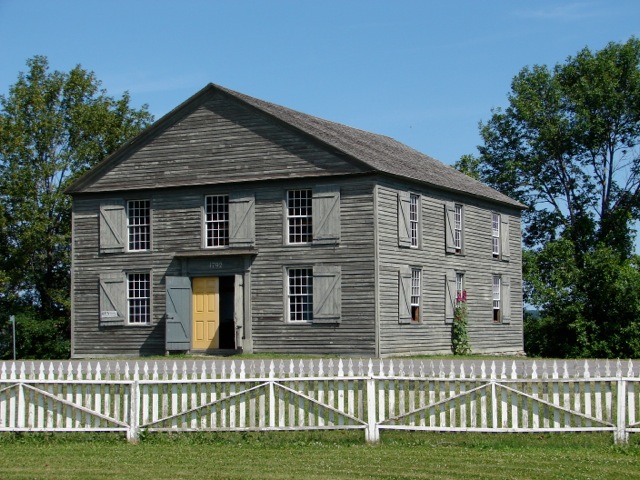The Grand Old Lady of Hay Bay, as it is known casually, is wearing a new dress. In the fall of 2019 workmen installed new siding on the Lady, the oldest Methodist structure in Canada.

For two and a quarter centuries, the old wooden church has been greeting passersby as they scoot along the South Shore Road of Hay Bay near Adolphustown. It stands as a stolid, solid reminder of the faith of the original Loyalist settlers who struggled to establish new lives in the remote Canadian wilderness.
Of course, the church wasn’t always old. It was brand new in 1792, when it was erected by a group of earnest and thankful pioneers whom we have come to know as Loyalists. It was established only eight years after the original pioneers reached Adolphustown, having been driven from their homes in the new republic to the south. They chose a site on Hay Bay, an arm of Lake Ontario near Prince Edward County in eastern Ontario.
Despite the difficulties of establishing their own homes and farms, they found time and energy to erect a house of worship, called a meetinghouse, in the wilderness of southern Lennox & Addington County. Gathering in worship was very important in their lives, and they found that none of their houses was sufficiently large. A circuit rider named William Losee persuaded them to construct a meetinghouse. Although it was primarily a church used for Sunday services, it also doubled occasionally as a courthouse and a public meeting space for other occasions.
Old Hay Bay Church still exists, thanks to the faithful volunteerism of a different kind of Loyalist. It has survived a challenging life, basking through more than 200 summers in an idyllic bayside location and hunkering down through more than 200 winters as icy winds swept up the bay. It is the oldest Methodist church extant in Upper Canada.
It was built with volunteer labour, on land donated by Paul Huff whose descendants still reside in the area, with materials sourced locally from big stands of tall pine. Massive timbers and mammoth floorboards can still be seen, evidence of the bountiful forest resources readily found all around the church.
It is unlikely that the workmen who pieced together posts and beams and hammered wooden dowels into place ever thought that their handiwork would be evident more than two centuries later. And yet the church survives, thanks to the continued volunteerism of a group of friends and supporters – some of them descendants of the original 22 founders. They ensure that the building is open to visitors each and every day from the 24thof May through the summer. An annual pilgrimage service is held on the fourth Sunday of August.
Truth be told, the church has not enjoyed constant enthusiastic and ecclesiastical loving since its inception. It was once abandoned as a church. From the 1860s to 1910, the structure was used by a farmer as a granary and equipment barn. A clergyman who visited it during this period was moved to tears: “there are still here and there traces of paint on the clapboards, but in the distance it looks dirty and weather-worn. Sitting almost in the waters of Hay Bay, it looks more like a store-house than a place of worship.”
The farmer respected the origins of the structure. The building was still standing, relatively intact, in the early 1900s when senior members of the Methodist Church recognized its historical significance. Talk of church union may have motivated them to retain an important memorial to Methodism. The Methodist General Council of 1910 approved the purchase of the building. It was recovered from the then-owner, Walter Platt, for $400. Another $1,000 was spent on replastering the walls and ceiling, adding a flagpole on the north wall, and doing what was necessary to “preserve large sound timbers from decay and to afford a rough interior for public worship.” A celebratory service was held in 1912.
Skip ahead now another 106 years. Once again the building in the distance looked dirty and weather-worn and required substantial restoration to “preserve large sound timbers from decay.” Costs have risen substantially over the decades, and today the trustees are raising $300,000 in a capital campaign that will not only restore the church but also the companion custodians’ cottage and the adjacent cemetery, and provide secure storage for church artifacts and records.
The Board of Trustees manages to meet the ongoing costs of maintaining the property through a small grant from from the United Church organization, donations at the door of the church, sales of souvenirs, proceeds from an annual Pilgrimage Service in August, building rental for weddings and other services, and various donations and bequests from individuals.
However, the task facing the Board now is more daunting than casual contributions can cover. The most immediate concern was the installation of new siding and window frames to secure the church from water damage. As in 1910, further repairs are needed on the plasterwork inside. Sufficient funds to cover the exterior, including a generous $75,000 grant from the Parrott Foundation, have allowed the first part of the restoration to proceed. After the exterior has been allowed to age for a year or so, the church will be resplendent in a bright blue-grey coat of paint – the original colour.
With church union in 1925, Old Hay Bay Church became a property of the new United Church of Canada. In 2000, the federal government recognized it as a National Historic Site. As trustees, members of the board feel it is incumbent upon them to find the financial resources necessary to prevent deterioration of Old Hay Bay Church. Not only is it material evidence of the early years of one of the founding branches of the United Church, but it is also a true educational artifact reflecting the strong personal faith of pioneering Canadians.
Board chairman the Rev. David Jones says, “Preserving the Old Hay Bay Church is much more than just maintaining an old building. This historic site does indeed represent a moment of time, 225 years ago, when Loyalists were establishing a new homeland. But OHBC also reflects the continuing story of the generations who have followed, including those who have no direct ancestral link to its original congregation.
“Refugees from war, immigrants seeking a better economic future, and diverse families drawn together by the desire to be part of a new community – these are the countless stories we all have, as Canadians, across our whole nation. Hoping and daring, welcoming and building, are symbolized in the Old Hay Bay Church. When we are part of supporting this site, we are reaffirming our commitment to the values and dreams in that Canadian heritage. Doing so is both a joy and an honour.”
Contributors may send their support by cheque mailed to Old Hay Bay Church, c/o Jen Welch-Wilson, P.O. Box 53, Yarker, ON, K0K 3N0 or by donating on-line through our website at www.oldhaybaychurch.ca. Please clearly indicate on your cheque that the money is for the OHBC Restoration Fund. Follow the progress of our project on Facebook or on our website.
With proper restoration, the Old Hay Bay Church may continue to serve another 100 years. Or 200, or more, evidence in perpetuity that the Methodist Church played a founding role in the creation of our national culture.
Further information: http://www.oldhaybaychurch.ca/
*Orland French of Belleville is a former trustee of Old Hay Bay Church.













